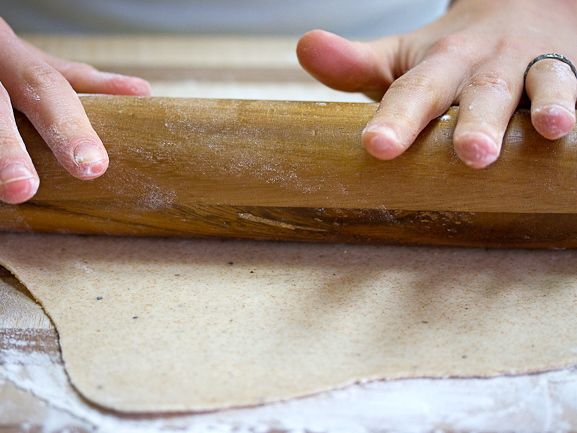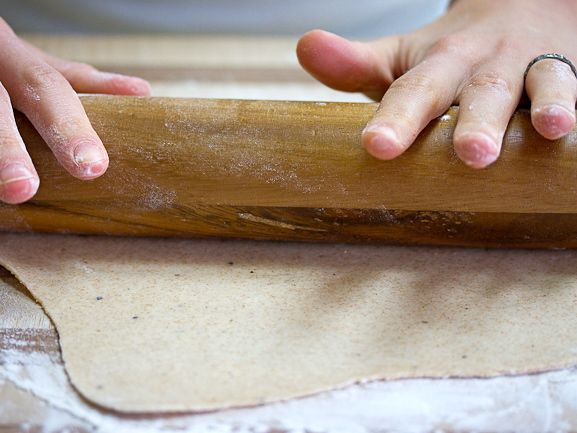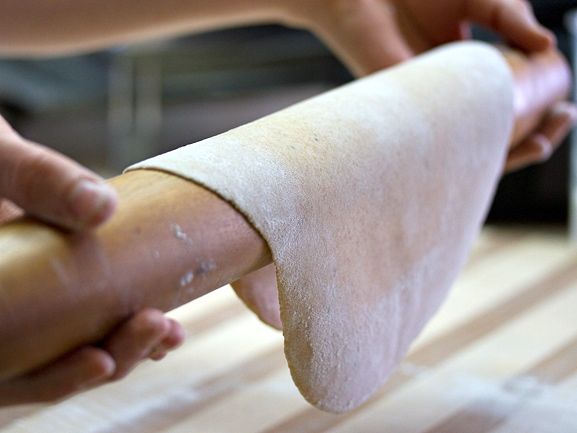
reference-image, l
(post, Megan Scott)
When I am at my most harried and discouraged, I remember quiche. When two hailstorms in three days tatter my spring garden. When taxes are due, the chicken coop needs cleaning, and the aspic recipe I was testing sticks, irreconcilably, in its mold. As days lengthen, it seems there is less time than ever for the luxurious pleasure of cooking for the sake of cooking. When cooking falls off the back burner, a jar of peanut butter with a long spoon often provides my nourishment. I make a big batch of granola and reach far back in the freezer for the half loaf of stale bread I couldn't bring myself to throw away. Dinner's served. But usually, and most often when I am tired and feeling uninventive, I, thankfully, think of quiche. Few dishes manage to be so comforting and frugal while remaining refined. Quiche's components can be made ahead of time; almost anything, including leftovers, can be added to it; and it can serve as breakfast, lunch, or dinner. Or all three in succession. Served with salad, it makes a meal. [[block(sidebar). h1.Featured recipe]] The crux is the crust. For quiche to be quiche, the crust is essential. Crustless, you have a frittata — a worthy dish in its own right, but one that is distinct from quiche. Mention crust, however, and many of you may sigh, recalling tough, shrunken shells that looked as though an ill-tempered cat prepared them. But I have discovered why unsuccessful or inferior crusts are so common: pie dough can sense fear. Of course, there's more to it than that. It does matter what kind of flour you use, or if you overwork the dough, or what kind of fat and how much you use. But the clincher — and perhaps what is hardest to understand, and even more difficult to explain — is that it matters how you approach your dough. Romantics, Luddites, and purists, avert your eyes. I was once under the impression that making pie dough with anything other than your hands and maybe a pastry blender was a travesty. Something not to be done. Ever. [%image reference-image float=right width=400 caption="Roll out your dough with intent."] And then I left college, started working full time, planted a garden, and got chickens. I still wanted to make the dough myself rather than resorting to the specimens in the freezer case at the supermarket, but I was, like an unfortunate pie dough, stretched a little too thin. Now, I almost always use a food processor to make pie dough, unless I have extra time or am feeling particularly contemplative. And I have never, up to now, made a tough crust with the food-processor method. Perhaps this is because I have always read that you are much more likely to overwork the dough in a food processor, and thus I am more vigilant. In any case, using a food processor is one of those tricks that brings quiche a little closer. You can make the dough in five minutes in the morning before you go to work. Or you can make it at your leisure and refrigerate it for up to three days or freeze it for up to a month. Dough needs a firm but restrained hand. After giving the dough a long rest in the refrigerator, it may be tough and unyielding. Let the dough rest for several minutes at room temperature, and then give it a fair number of healthy thwacks with a rolling pin to loosen it up a bit. If you try to roll out a very cold, very hard piece of dough, it will crack. This is not the end of all things, but you can save yourself the frustration. Roll out your dough with intent, pausing to rotate the dough to prevent sticking. This is crucial. One of the more common mistakes I see in this regard is the cook moving around the dough, approaching it warily from every direction. You must move the dough rather than letting the dough move you. Move it constantly. After every stroke of the pin, rotate the dough. At any sign of sticking, throw a little flour underneath and keep going. At first, this will feel awkward, but you will come into your own soon enough. [%image droopy float=left width=400 caption="Dough ready to be draped over the dish."] This happens to be my favorite part of making quiche. The fine, sanded feel of the pin rocking beneath my palms; the dynamics of the dough; the constant risk of sticking or tearing and the satisfaction of troubleshooting on the spot; the brief elation of winding the rolled dough around the pin to drape over the pie dish. It's a little bit of a baker's rush to see flour and butter turn into a flaky, tender crust. Having said that, I'll admit to making more than my fair share of mediocre pie crusts. Until I honed the rotating method, I had a bad tendency to stretch the dough, resulting in shrunken crusts wearing pie tins that looked much too big for them. Then there were the torn crusts, patched up to within an inch of their lives. There were times when I wanted to ditch the whole effort, go to the grocery store, and get it over with. But you know what? Even my worst crusts were perfectly edible, and the ugliest of them all tasted better, truer, than any supermarket crust I've tasted. And I've learned more than a few things in the process. Roasted Vegetable Quiche Serves 4 to 6 as a main dish, 6 to 8 as part of a larger meal Note: The addition of cream cheese to the dough makes for an extra flaky, malleable crust. Of course, you can always just insert your own favorite dough recipe here. Make the crust at least eight hours ahead of time. In a food processor or a large bowl, combine: 1 cup whole spelt flour 1/4 teaspoon kosher salt 1/4 teaspoon freshly ground black pepper Fresh or dried herbs, thyme, rosemary, or oregano are good here Add and pulse or blend until the mixture resembles very coarse cornmeal: 1/2 cup (1 stick) cold unsalted butter, cut into small cubes 4 1/2 ounces cold cream cheese Add and pulse or blend until the dough just comes together in a shaggy ball (this may take 30 seconds or more; at first, the dough will seem reluctant to pull together, but trust me, it will in time): 1 tablespoon ice water Remove the dough and press into a ball. Flatten the ball into a disk, wrap in plastic wrap, and refrigerate for 8 hours, or up to three days. The dough can also be frozen for up to a month. Roast the vegetables. This step can also be done ahead of time, whenever you find yourself at home and the oven is unoccupied. Roasting vegetables requires very little vigilance. Preheat the oven to 400 degrees. Prep any vegetables you have that you'd like to add to the quiche. Some of my favorites are as follows: Golden beets, roasted whole in tinfoil Cherry tomatoes, roasted in a little olive oil Eggplant, cut into slabs if large, roasted whole if small Carrots, roasted whole Whole heads of garlic, top thirds cut off and roasted in foil with olive oil Potatoes, cut into cubes and roasted Summer or winter squash, cut into cubes and roasted Of course, you'll need to know your vegetables, and expect some of them to be done more quickly than others. There's no rushing this process. In spite of the craze surrounding crisp-tender vegetables, I'm going to insist that you let your vegetables get nice and soft. That's just how it needs to be for this dish. An hour before baking your quiche, remove the dough from the refrigerator and allow it to sit at room temperature for a few minutes, or until reasonably pliable. Give it a few thwacks, like we talked about earlier. You aren't going to hurt it. Lightly flour your work surface and begin to roll, turning the dough as you go. Turn it every chance you get, and if it begins to stick, throw some flour under it. Roll until it is 1/8-inch thick and reasonably round. Roll the dough around your rolling pin and transfer it to your 9- or 10-inch pie dish or tart tin. Mold the dough gently into the dish and trim any excess. There should be enough excess dough for a small galette the next day. Refrigerate the dough for 30 minutes and preheat the oven to 400 degrees. After 30 minutes have passed, line the dough with parchment or tin foil and fill with pie weights or beans. Press the beans down to ensure that there are no air pockets or places where the dough can puff up. Bake for 15 to 20 minutes, or until the dough is set and starting to brown at the edges. Remove the beans and foil, brush the dough with a beaten egg yolk, and return to the oven for 7 to 10 minutes more, until the egg wash has dried and the dough is golden. Fill the crust with 2 to 3 cups of the roasted, roughly chopped veggies, depending on how dense you want the quiche. In a medium bowl, whisk together until well blended: 4 large eggs 1 cup heavy cream, half and half, whole milk, or even buttermilk 1/2 teaspoon kosher salt 1/4 teaspoon freshly cracked black pepper 2 ounces mild cheese of your choice, finely grated Chopped fresh herbs, to taste A pinch of freshly grated nutmeg Pour over the roasted veggies and bake until set and beginning to brown on top, about 25 to 30 minutes. Allow to cool slightly before slicing. Serve with a green salad and an improvised simple tomato sauce if you like.

reference-image, l

reference-image, l

droopy, l